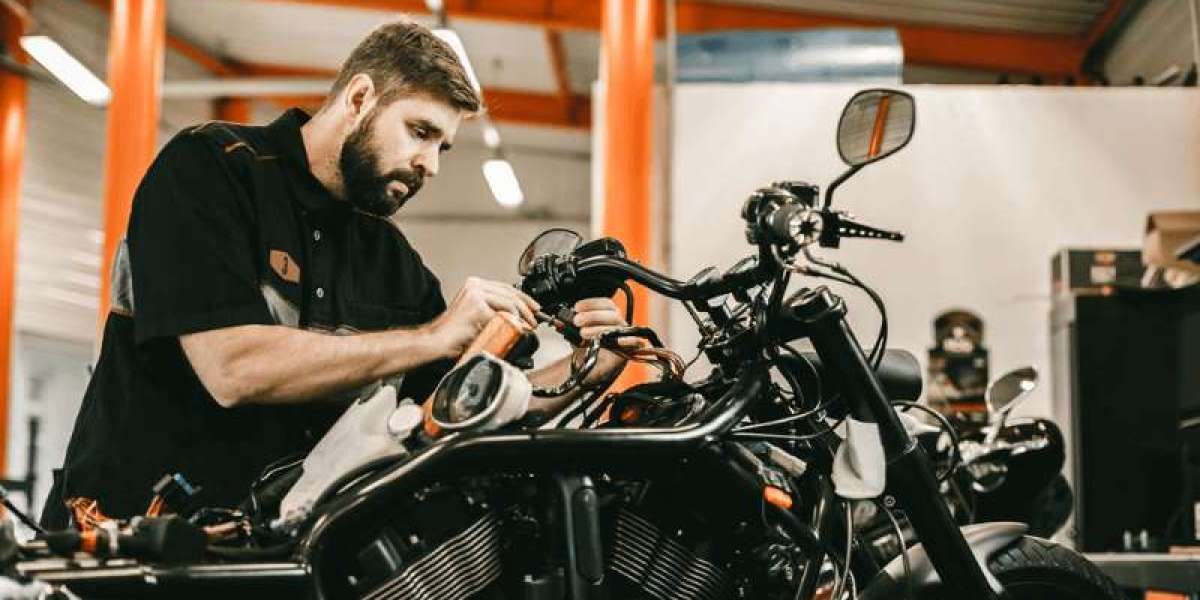Every time you turn the key and press the start button, you're relying on your motorcycle's ignition system to fire up the engine and get you on the road. But have you ever wondered how this process works? The ignition system is one of the most crucial components of your bike, ensuring the proper timing and delivery of sparks to the combustion chamber. A well-functioning ignition system is essential for smooth engine operation, better fuel efficiency, and overall performance.
In this blog, we will explain how motorcycle ignition systems work, break down the key components, discuss troubleshooting tips for common ignition problems, and emphasize why regular maintenance is critical. If you're new to working on motorcycles, understanding the ignition system and performing regular checks can prevent common failures and keep your bike running like new.
1. How the Ignition System Works
The primary purpose of the ignition system in a motorcycle is to generate a spark that ignites the air-fuel mixture inside the engine’s combustion chamber. This spark happens at precisely the right moment, ensuring optimal combustion and engine performance.
A motorcycle's ignition system consists of several important components:
Key Components of the Ignition System
Battery
The battery powers the ignition system by providing the electrical energy needed to generate sparks. It stores and supplies voltage to key ignition components, including the ignition coil and the CDI (Capacitor Discharge Ignition) unit or ECU (Electronic Control Unit).Ignition Coil
The ignition coil is responsible for stepping up the voltage from the battery to a much higher voltage required to create a spark at the spark plug. The coil transforms low-voltage current from the battery into the high voltage that ignites the fuel-air mixture.Spark Plug
The spark plug is the component that creates the actual spark to ignite the compressed fuel-air mixture. The spark ignites the mixture, causing an explosion inside the combustion chamber, which forces the piston down to create power for the engine.CDI/ECU (Electronic Control Unit)
The CDI or ECU controls the ignition timing. It determines when the spark will be delivered to the spark plug, based on the engine's RPM (revolutions per minute) and other factors. Modern bikes often use ECU-based systems that offer more precise control of ignition timing.Stator and Rotor
These are essential for generating the electrical energy that powers the ignition system. The rotor spins and generates a magnetic field, which is converted into electrical energy by the stator. This energy is sent to the ignition coil to produce the necessary spark.
When you turn the key and push the starter button, the battery sends electrical power to the ignition coil. The coil converts the voltage, sending a high-voltage charge to the spark plug, which ignites the fuel-air mixture in the combustion chamber. This process must occur at exactly the right time to ensure smooth engine operation.
2. Why Ignition System Maintenance is Crucial
Regular maintenance of your ignition system can significantly improve your motorcycle's performance and prevent costly repairs. The ignition system’s components are exposed to a lot of heat, wear, and tear, making them prone to failure over time. Here’s why routine checks and maintenance are essential:
Common Ignition System Issues
Hard Starting
If your motorcycle is difficult to start, the issue could be a weak or dead battery, dirty spark plugs, or a malfunctioning ignition coil. This can lead to delayed starts or no start at all. Neglecting battery maintenance can also cause electrical problems that affect the entire ignition system.Misfires
Engine misfires happen when the spark fails to ignite the fuel-air mixture correctly. This can cause the engine to run roughly, lose power, or even stall. Misfires are often caused by worn spark plugs, incorrect ignition timing, or a malfunctioning ignition coil.Poor Fuel Efficiency
If the ignition system isn’t working optimally, the engine might not burn fuel efficiently, leading to decreased fuel economy. A poorly functioning ignition system results in incomplete combustion, wasting fuel and negatively impacting mileage.Stalling While Riding
Stalling can occur if the ignition system isn’t delivering the spark at the correct time. Inconsistent sparks can cause the engine to stall or cut out mid-ride, which can be dangerous, especially at higher speeds.
Maintenance Tasks to Ensure Reliable Ignition System Performance
Inspect and Replace Spark Plugs
Spark plugs play a critical role in the ignition process. They can become fouled with carbon deposits or wear out over time. Regularly inspect and clean your spark plugs, and replace them if you notice signs of damage or wear. Changing your spark plugs every 5,000-10,000 miles (or as recommended by the manufacturer) will keep your ignition system running smoothly.Check the Battery
The battery is the heart of the electrical system. A dead or weak battery can result in hard starting or a complete failure of the ignition system. Regularly check the battery’s voltage, ensuring it’s holding a proper charge. Clean any corrosion from the terminals and replace the battery if it’s no longer holding a charge.Test the Ignition Coil
The ignition coil is crucial for generating the high-voltage spark needed to start the engine. A faulty ignition coil can cause poor starting, misfires, and overall engine performance issues. You can test the ignition coil with a multimeter to check for continuity and resistance. If it’s not functioning properly, it’s time for a replacement.Inspect the CDI/ECU
If your motorcycle uses a CDI or ECU, you’ll need to check these components to ensure they are functioning properly. A malfunctioning CDI or ECU can result in improper spark timing and cause poor engine performance. If you’re having trouble with the ignition timing or experiencing misfires, it may be time to inspect or replace these components.
3. Enroll in a Motorcycle Mechanic Course for In-Depth Knowledge
Understanding the intricacies of your motorcycle’s ignition system can be challenging, especially if you're new to bike maintenance. Enrolling in a motorcycle mechanic course can help you gain in-depth knowledge and hands-on experience with all the components of your bike's ignition system.
These courses teach you how to troubleshoot common ignition issues, properly maintain the system, and replace faulty components. You’ll also learn about other key systems on the bike, such as the engine, fuel system, and electrical system, which all work together to keep your bike running at its best. By understanding the mechanics of your bike, you’ll be more confident in handling issues yourself and performing effective maintenance, potentially saving money on repairs.
In addition to ignition systems, a motorcycle mechanic course covers topics such as engine diagnostics, transmission maintenance, and troubleshooting. This comprehensive knowledge helps you stay ahead of potential problems and ensures that your motorcycle stays in top condition.
4. Troubleshooting Common Ignition System Problems
If you're experiencing problems with your motorcycle's ignition system, here are some common issues and troubleshooting tips:
Problem 1: Motorcycle Won’t Start
- Possible Causes: Weak or dead battery, faulty ignition coil, worn spark plugs, or problems with the CDI/ECU.
- Solution: Check the battery voltage, clean the terminals, and charge or replace the battery if necessary. Inspect the spark plugs and replace them if they’re fouled. Test the ignition coil with a multimeter and replace it if it’s faulty. If your bike uses a CDI or ECU, check for any faults in the wiring or connections.
Problem 2: Engine Misfires
- Possible Causes: Worn spark plugs, incorrect ignition timing, or a malfunctioning ignition coil.
- Solution: Replace worn or dirty spark plugs. Inspect and adjust the ignition timing as needed. Test the ignition coil and replace it if necessary.
Problem 3: Poor Fuel Economy
- Possible Causes: Incorrect ignition timing or dirty spark plugs.
- Solution: Ensure that the ignition timing is correct. Replace or clean the spark plugs to ensure optimal combustion.
Problem 4: Stalling While Riding
- Possible Causes: Faulty ignition system components such as the ignition coil, CDI, or ECU.
- Solution: Inspect the ignition coil, CDI, and ECU for damage. Check for loose connections and faulty wiring. Replace any faulty components.
5. Final Thoughts
The ignition system plays a vital role in your motorcycle’s performance and overall reliability. Regular maintenance of components like the battery, spark plugs, ignition coil, and CDI/ECU ensures that your bike starts quickly, runs smoothly, and performs at its best. By staying on top of these maintenance tasks, you’ll avoid common ignition-related problems and keep your bike in great condition for years to come.








